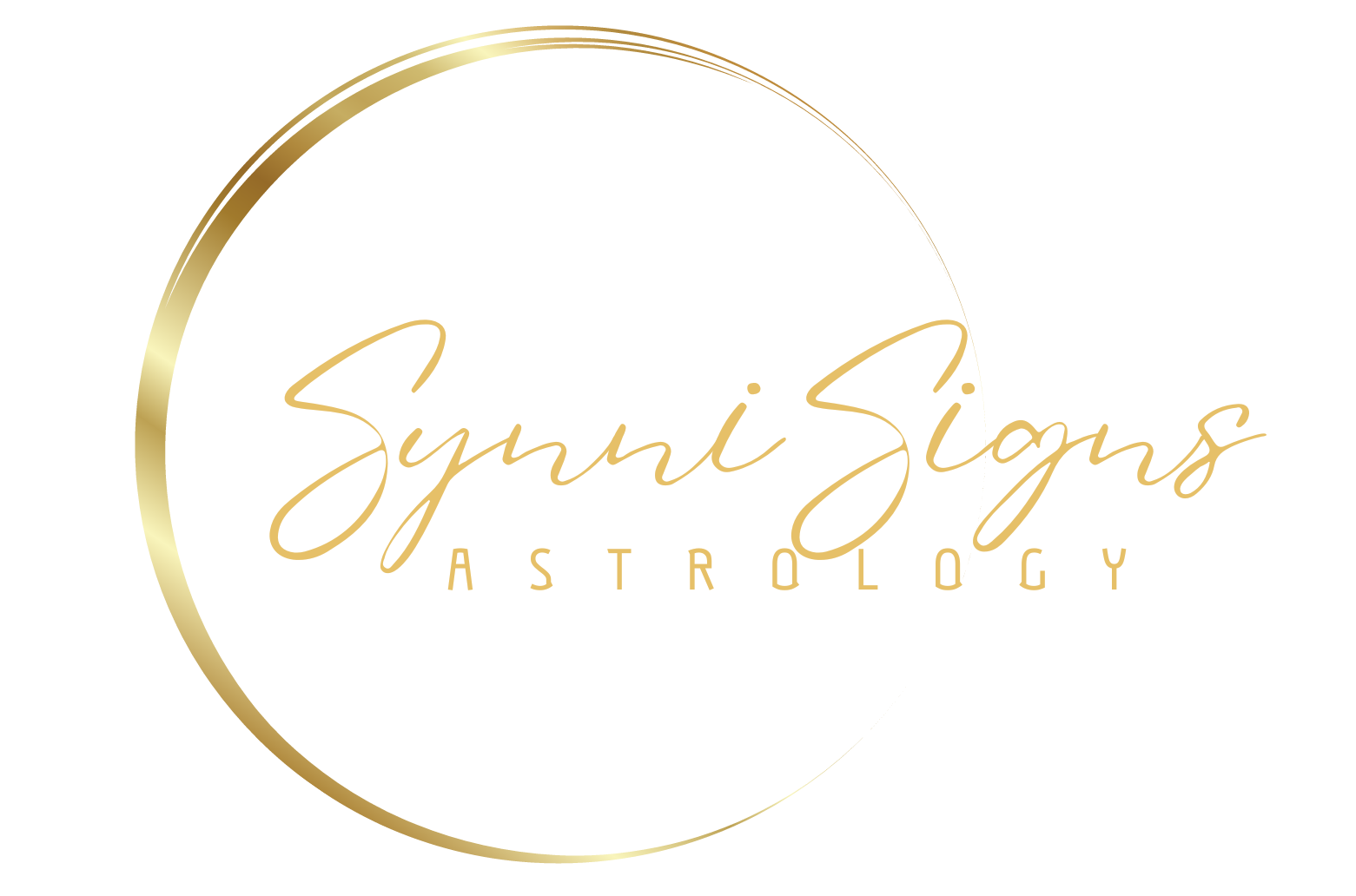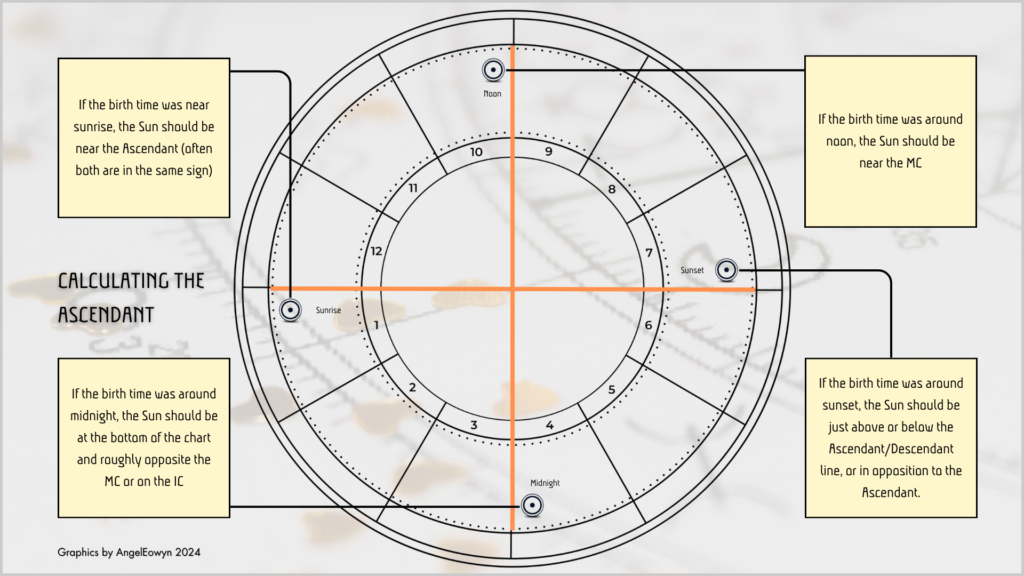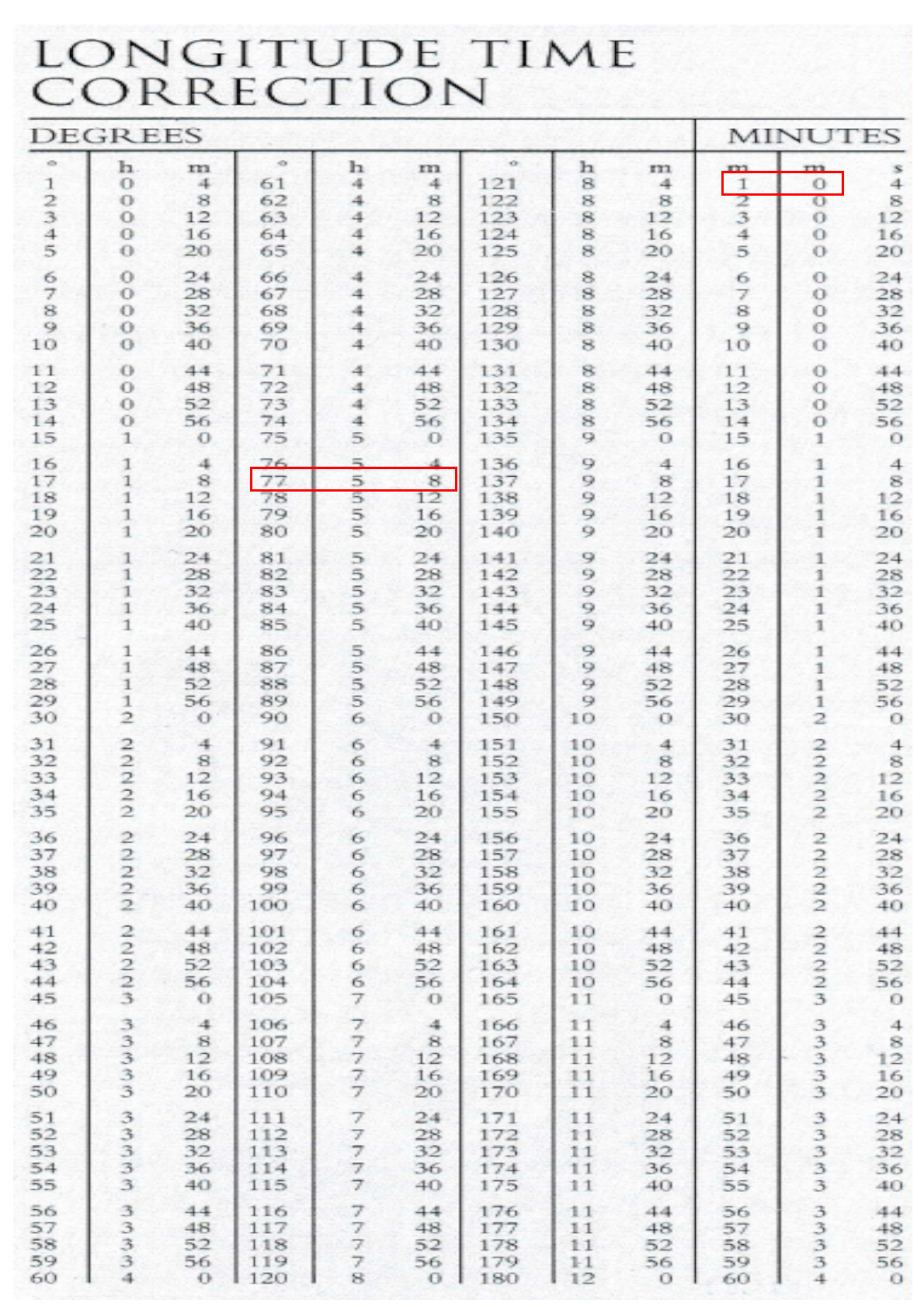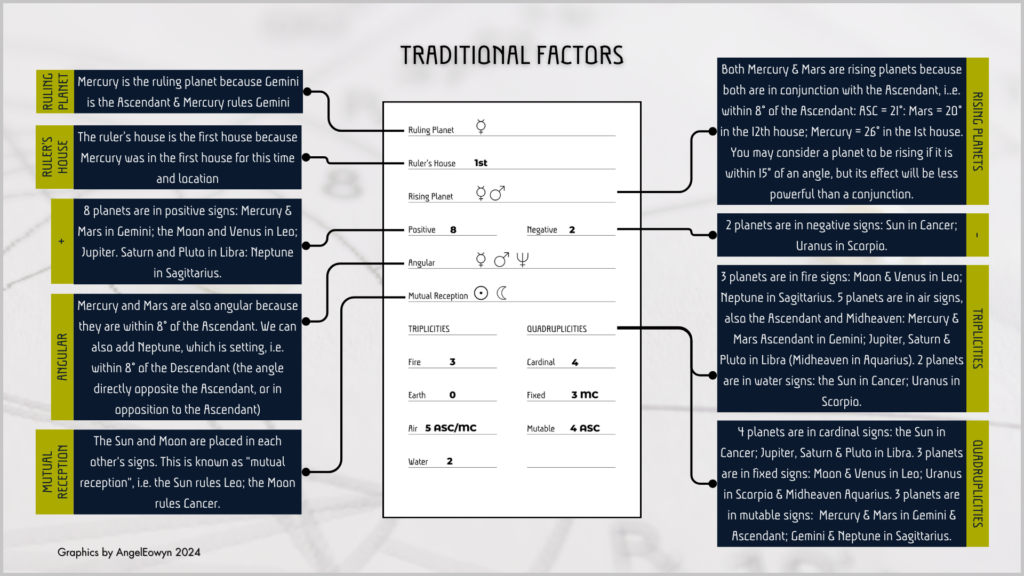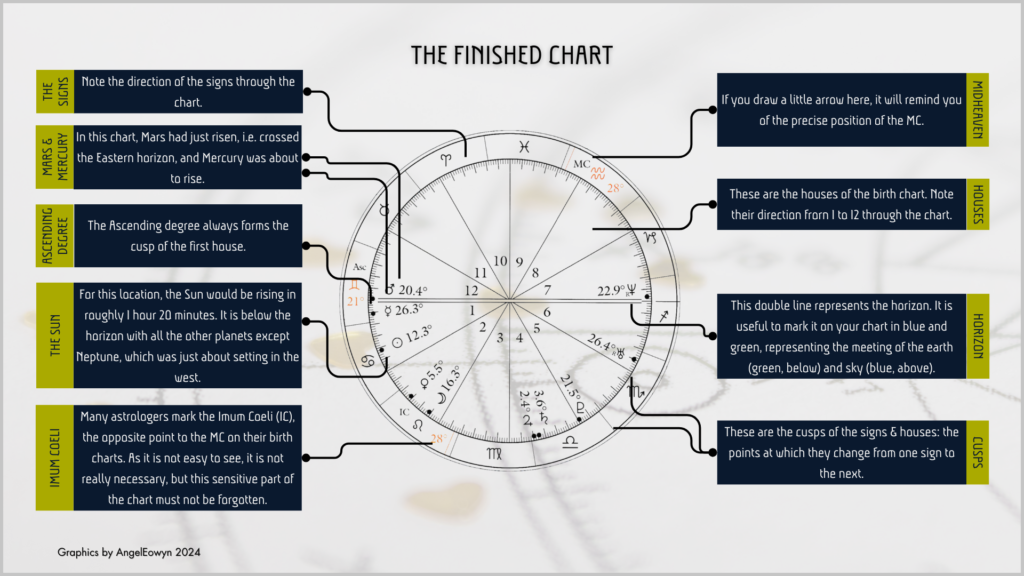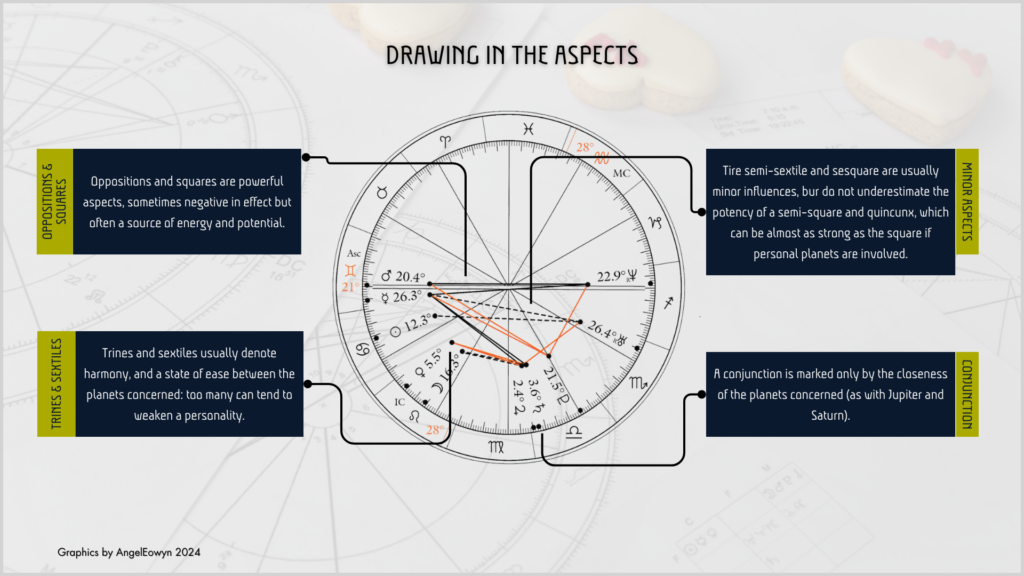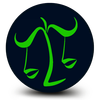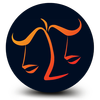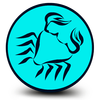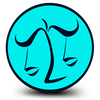
Astrology for Geeks!
A natal chart, also known as a birth chart, is a celestial map that displays the positions of the planets at the moment of an individual’s birth. The location where someone is born influences the configuration of the sky, so even if two people share the same birth date and time but were born in different cities or countries, their natal charts will be distinct due to the varying positions of celestial bodies. Thus, to create a birth chart, precise details such as the birth date, time, and place are required. It is worth noting that it is so much easier to find an online site these days where you can just input the birthdate and time and get all the information you want, including a full chart. For example, astro.com is a good place to start. However, if you are geeky like me, you might actually enjoy calculating everything yourself armed with a mere calculator and a few necessary resources, most of which you can find online. This is where I walk you through those calculations. I will also supply all the relevant documents, resources and templates to make this a little easier for you 🙂
What you will need:
- Longitude & Latitude of place of birth (Atlas or Google Earth)
- Swiss Ephemeris Table of Houses www.astro.com
- Longitude Time Correction table The Sundial Primer – Longitude Correction (mysundial.ca), or download PDF
- A list of time zones for Daylight Saving Time that was in effect at the time of birth in the birthplace (Wikipedia is a good source)
- Table of Houses for Northern Latitude (needed for the calculation of Ascendant/Descendant position) (Download here)
- Ephemeris (list of planetary positions on the time of birth) (Available here)
- Calculator (online)
- Birth Chart Wheel Template (Download here)
- Traditional Factors Template (Download here)
- Zone Standard Times (www.astro.com)
You can also find many resources and links from my Charts page
Calculating the Birth Chart
To create a birth chart, you need to determine the precise positions of the Sun, Moon, and planets at the specific moment for which the chart is being prepared. In the past, this calculation was performed using logarithms, but nowadays, the process is simplified with the help of pocket calculators or online tools. However, it’s essential to use a calculator that can convert decimal fractions into degrees and minutes accurately. An ephemeris provides a reference for the planetary positions, typically listed in degrees and decimal points. I can guide you through the process of calculating these positions with a reasonable level of accuracy.
PREPARING THE TEMPLATE
First, prepare the birth chart wheel. You can either create your own or download one from here to use as a template.
CALCULATING THE ASCENDANT AND MIDHEAVEN
The process varies slightly depending on whether the birthplace is to the east or west of Greenwich.
WEST OF GREENWICH
To create our sample birth chart, let’s use the details of a fictitious person named Oscar, born in Washington DC, USA, on July 4, 1981, at 04:19 a.m. local time. Enter the birthplace, date, and time on the chart.
(i) Refer to an atlas or Google Earth to find the latitude and longitude of the birth place. For Washington this is 38o 52’N, 77′ 01’W. Document the latitude and longitude on the birth chart form.
(ii) Convert the local time to Greenwich Mean Time (GMT). Local summer time (Daylight Saving Time) may have been in force during the time of year that your subject was born. In our example, summer time was in force, so the clocks were an hour ahead and the local standard time was therefore 3.19 a.m. This now needs to be converted to GMT. Consult the table of zone standard times (download here). This shows that Washington is five hours behind Greenwich, so you need to add five hours to the local standard time – the GMT time of birth now becomes 8.19 a.m. Enter this on the birth chart form. When converting the local birth time to GMT, the birth date may change, either moving forward to the following day, or back to the previous day: double-check this, and document the corrected GMT date on the form. As from now, we will be using this GMT time and date in all of our calculations.
(iii) The Ascendant and Midheaven are found by converting the GMT birth time into sidereal time (ST). Download the Sidereal Time Table here. Using this table, which displays the Sidereal Time for the date in question. However, this must be slightly corrected for each year. This corrective information is shown in the small table at the bottom of each page as “extra minutes” which need to be added to the figure you get from the main table. Using our example of Oscar, the Sidereal Time for 4th July is 18.45.50. The correction is 1.51 thus giving us the end result of 18.47.41 (18.45.50 + 1.51 = 18.47.41). Write this in your form.
(iv) This is, however, the ST for midnight (the beginning of the day) at Greenwich. Now, you need to convert the ST to the time of birth (still at Greenwich) by adding the GMT time of birth that we got from point (ii) to the ST.
ST 18.47.41 + GMT time of birth 8.18 = 27.06.11. This can now be rounded up to 27.07. Always keep in mind that we are working in minutes and seconds within our calculations.
(v) Sidereal time is like a clock that seems to advance approximately four minutes each day due to what’s known as the “acceleration of the time interval.” Typically, this factor needs to be considered, except when the time interval is three hours or less, in which case it can be disregarded.. If the interval is between:
3 and t hours – add 1 minute;
9 and 15 hours – add 2 minutes;
15 and 21 hours – add 3 minutes;
21 and 24 hours – add 4 minutes.
The exact guideline involves adding 10 seconds per hour, or 1 second per 6 minutes. However, in most cases, the previous suggestion will suffice for accuracy. In our example, we will add one minute, resulting in the sidereal time becoming 27.08.
Note: If the sidereal time exceeds 24 hours, subtract 24 hours from the total. If the longitude equivalent needs to be subtracted and is greater than the sidereal time (resulting in a negative figure), add 24 hours to the sidereal time before performing the subtraction.
(vi) The sidereal time result we have now is the true sidereal time of birth if the subject had been born at Greenwich. However, since that is not the case, we must now adjust this sidereal time to become the sidereal time for the place of birth, which in our example is Washington DC.
The table on the left is utilized to convert the degrees and minutes of the longitude of the place of birth into time – the hours and minutes you need to add to or subtract from the sidereal time. To do this, subtract for places west of Greenwich and add for places east of Greenwich. This is known technically as the longitude equivalent.
In our example, the table for the degrees gives us 5.08, as the longitude for Washington DC is 77° 01′ W. To determine the minutes correction, refer to the column on the far right and locate the 01′, which in our example gives us 0 minutes.
ST = 27.08 – 5.08 – 0.00 = 22.00, which is the true ST of birth for Washington DC. Input this into your chart form. Calculation of the local ST is now complete. However, if the birth place of your subject is south of the Equator, here is what you need to do:
SOUTHERN LATITUDES
A minor adjustment enables us to utilize tables meant for northern latitudes to determine the Ascendant and Midheaven for births in southern latitudes. For instance, we can employ the identical birth time but adjust it for Perth, Western Australia (31° 57’S, 115° 52’E). At the moment of birth, the local sidereal time is 10:51 a.m. Adding 12 hours yields 22:51. Therefore, the corresponding time becomes 10:51 p.m.
Using the Swiss Ephemeris Table of Houses, we can see at 22.51 (10.51 p.m.) the tables show a Midheaven of 12° Pisces and an Ascendant of 29° Gemini. Reverse these to obtain the opposite signs. The correct combination for this birth chart for Perth (latitude south) will therefore be Midheaven 12° Virgo, Ascendant 29° Sagittarius.
To determine the Midheaven (MC) and Ascendant (AC), consult the table of houses. Locate the column adjacent to the nearest calculated Sidereal Time (ST) for the Midheaven. Then, find the relevant latitude column and identify the intersection point with the corresponding Sidereal Time to find the Ascendant (AC).
Note: When calculating the Midheaven and Ascendant, we round each value to the nearest whole degree. For instance, 2.3° becomes 2°, and 3.5° becomes 4°. In the provided example, the Midheaven is positioned at 27.8° Aquarius, rounded up to 28° Aquarius, while the Ascendant is at 21° Gemini.
EAST OF GREENWICH
When the birthplace is east of Greenwich, such as in Moscow (55° 45′ N, 37° 35′ E), but the time remains GMT on the same date, only one adjustment is necessary in your calculations. This adjustment affects the added longitude equivalent. Therefore, the Sidereal Time calculation now becomes:
3.08 (i.e. 27.08 – 24) + 2.28 + 0.02 =5.38.
Note the influence of latitude on the positions of the Midheaven and Ascendant. According to the Table of Houses for Northern Latitudes, the Midheaven is situated at 25° Gemini, while the Ascendant is at 26° Virgo.
CALCULATING THE PLANETS’ POSITIONS
To determine the positions of the planets at the moment of birth, you’ll require an Ephemeris. Astro.com offers various resources, including several Ephemerides. In these resources, the planetary positions are presented at 0 hr GMT (Midnight) and expressed in degrees and decimals, rather than degrees, minutes, and seconds. The required calculations are straightforward and can be applied to all planets.
(i) With a calculator, you’ll need to calculate the diurnal proportion, which means expressing the birth time as a fraction of the day of birth.
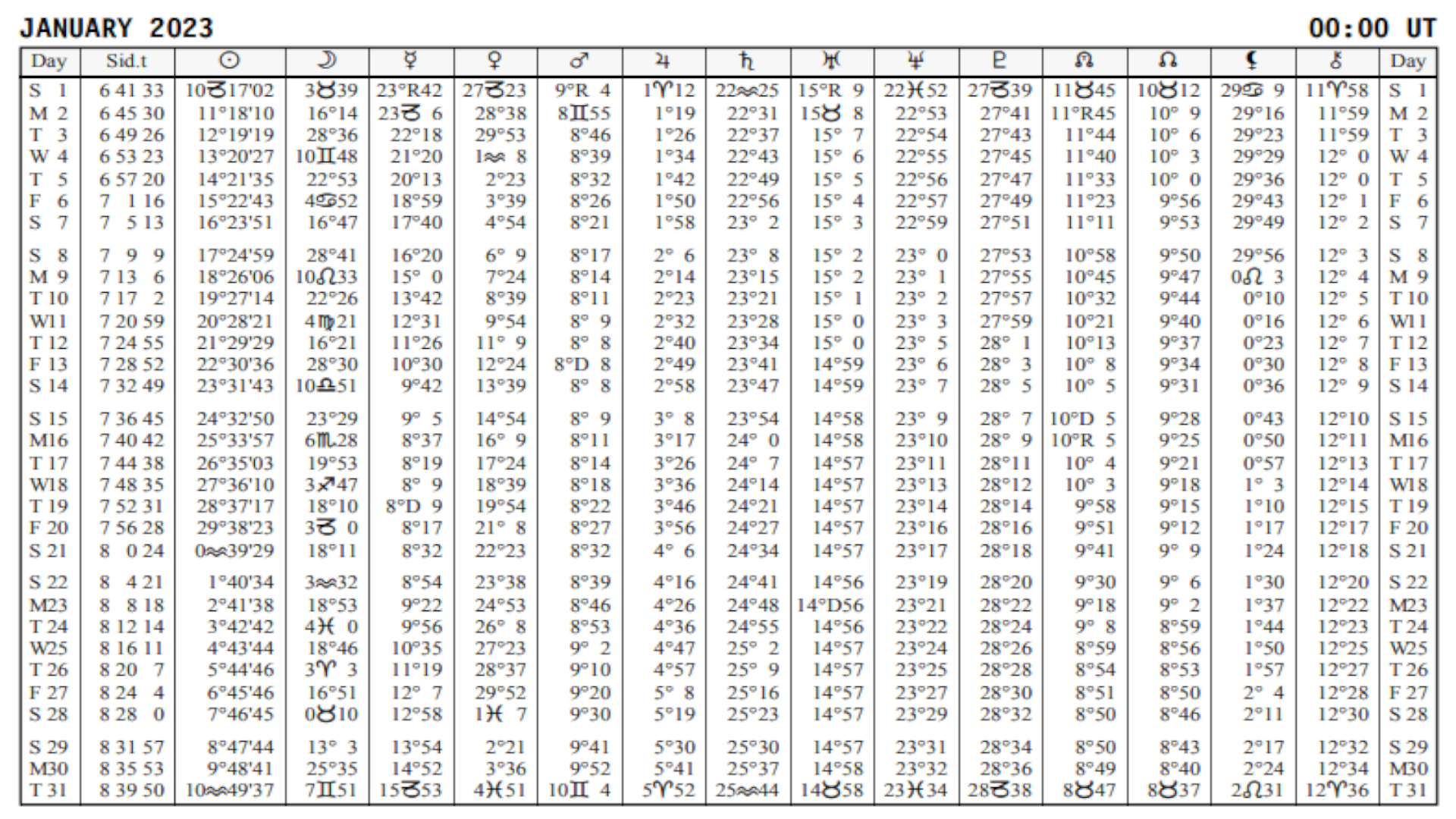
Divide the minutes (GMT time of birth) by 60, add the number of hours (GMT time of birth). Divide the result by 24 and, if possible, store this in the calculator’s memory.
19 ÷ 60 +8 = 8.31666667 ÷ 24 = .346527
This is the diurnal proportion, a constant, which is used in the following calculations which will apply to Sun, Moon, Mercury, Venus and Mars:
(ii) To calculate the position of a planet for a specific time on the GMT date, you can follow these steps:
1. Subtract the position for the GMT date (today) from the position for the day after the GMT date (tomorrow).
2. Multiply the result by the constant (diurnal proportion).
3. Add the today’s position to the result obtained in step 2.
This process allows you to determine the approximate position of the planet for the desired time on the GMT date.
Tomorrow – today x constant + today = result
In our example of 4th July 1981, the calculation for the Sun is as follows:
12.9 – 11.9 x .346527 + 11.9 = 12.24 i.e. 12.2° Cancer
For the moon:
24.8 – 11.2 x .346527 + 11.2 = 15.91 i.e. 15.9° Leo
(iii) The positions of Jupiter, Saturn, Uranus, Neptune, and Pluto can be directly obtained from the Ephemeris. If a planet is retrograde, you can still use the formula outlined above to calculate its position, but remember to denote the position with an ℞ to indicate retrograde motion.
(iv) Occasionally, and frequently in the case of the Moon, a planet may transition from one sign to another between consecutive days. In such cases, a slight adjustment is needed in the formula. For instance, if the individual were born at the same time on July 10th, the Moon would have shifted from 27.5° Libra to 9.4° Scorpio throughout the day. Consequently, the degrees would be counted as if there were no division between the signs.
In the provided example, even though the Moon would reach 9.4° Scorpio by the end of the day, we’ll consider the position as 39.4°. Therefore, we subtract 27.5° from 39.4°. The calculator formula will be:
39.4 – 27.5 x .346527 (diurnal proportion) + 27.5 =31.62
Since there are 30° in every sign, subtracting 30° from 39.4° would indeed make the Moon’s position 9.4° Scorpio. Let’s proceed with calculating the rest of the planetary positions and ensure accuracy.
(v) Referring to the list of planets’ groupings from the table “The Strengths of the Planets” you’ll input the planets, Ascendant, and Midheaven on the Traditional Factors sheet in their respective traditional groupings. You can download this template here for you to fill in.
CALCULATING THE ASPECTS
Planets are considered to be in aspect to each other when they form specific angular distances between each other.
(i) Using this orb table, which shows the various orbs permissible when calculating aspects. Always consider the shortest distance between two planets when determining aspects. If an aspect exceeds 188°, then consider the distance going the other way around the signs. Keep in mind that the opposition, at 180°, is the most distant aspect, and with the accepted orb of 8°, 188° is the maximum. The orb can be less or greater than the exact number of degrees for the aspect. For instance, a trine is exact when there are 120° between the two planets but will still be operative when planet A is on 10° Aries and planet B is on 18° Leo—or on 2° Leo. Go through each planet individually to identify all aspects.
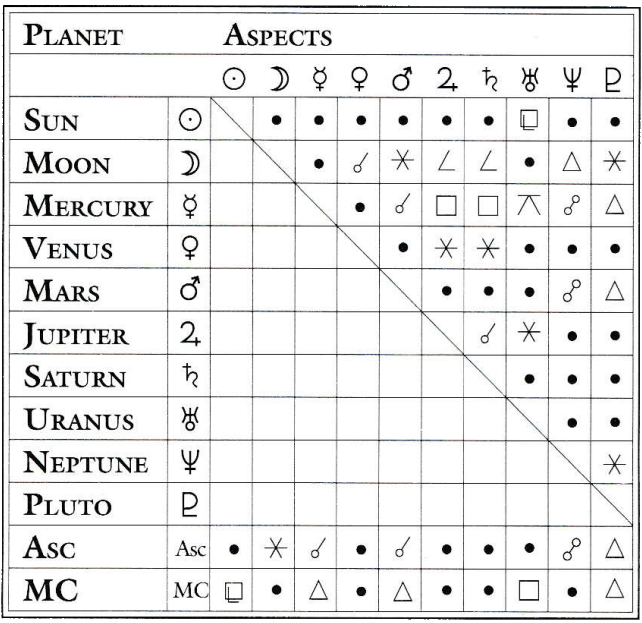
(ii) Still using Oscar’s chart as our example for 4th July, examine the Sun in relation to all the other planets, including the Ascendant and Midheaven and, using the appropriate glyph, enter this information onto an aspect grid like the one on the left. This will give you a clear overview of all the aspects at a glance, which is especially useful when doing Synastry charts. Oscar’s Sun is in Cancer at 12°. First, compare its position with the Moon, which is in Leo at 16°. There are 34° between the Sun and Moon. Every sign of the zodiac spans 30° so the formula is:
30° – 12° = 18° Cancer + 16° Leo = 34°
This is too wide to form a semi-sextile (⚺) which is 30° with a 2° orb. so we shall put a dot in the square of the table letting us know that there is no aspect here but that we did the calculation.
(iii) Next in line the Sun’s position to Mercury. Oscar’s Sun is in Cancer 12° and Mercury is in Gemini 26°. There are 16° separating them.
30° – 26° = 4° Gemini + 12° Cancer = 16°
Once again, there is no aspect so another dot is placed into the table between Sun and Mercury. Work your way through the signs using the same formula or any way that is comfortable for you. Basically, all you are doing here is calculating the distance between 2 planets. Oscar’s Sun didn’t make any aspects until we got to Uranus. 134° separate the Sun and Uranus making this a Sesquare (⚼) which is 135° with an orb of 2.2° thus allowing a span of 132.8°-137.2°. Draw the relevant glyph into the table.
The next part of the chart is, in my opinion, the hardest not because it is complicated but because it is time-consuming as you now work through all the possible aspects between every planet, the Ascendant and Midheaven. If you are feeling really adventurous, you can also calculate the Descendant and Imum Coeli, the Lunar Nodes (Karmic Astrology), Horary parts etc. This is how I have discovered people’s secrets and innermost qualities – purely by going into so much detail.
I compiled the orb table using every possible aspect available so it is possible to go into great detail with a person’s chart. Most astrologers will only look at the main aspects, but using this orb table will give you the opportunity to delve deeper if you so wish.
Drawing the Birth Chart
(1) Preparing the chart. Now that you have all your planetary positions and aspects documented, you can begin to create the chart wheel. Get an empty chart wheel to print out (you can download this one).
(2) Start with the Houses. Beginning with the horizon line on the left and working anti-clockwise, start numbering the segments in the inner circle with the houses 1-12. After a few times of doing this, you may not need to do this anymore as the house positions will become second-nature for you.
(3) Positioning the Ascendant. The double line across the middle of the chart represents the horizon at the time of birth. Taking this as 0°, move clockwise around the chart, counting off each degree to reach the number of degrees of the Ascendant. In our example, the Ascendant is 21° Gemini. The Ascendant marks the cusp of the first house and – whatever method of house division is used – the other houses follow suit, working anti-clockwise.
(4) The Sign Divisions. Starting at the Ascendant, count 30° in an anti-clockwise direction. This is the division or cusp of the 2nd Sign. Continue doing this for the rest of the signs.
(5) Putting in the Sign Glyphs. If you are not sure what the glyphs are, you can refer to wikipedia. They have an extensive list of all glyphs in different formats to download or copy. Now draw in the appropriate glyphs in the outer circle segments. They are generally drawn in vertically so no need to turn the paper making the glyphs face outwards.
(6) The Midheaven. Now draw in the Midheaven – the part of the sky that was directly overhead at the time of birth. For clarity, it is worth drawing the glyphs of the Ascendant and Midheaven in a different colour.
(7) Positioning the Sun and Moon. The Sun is now placed in its sign and house (12.3° Cancer in the 1st House). Next is the Moon which is in the 2nd House in Leo 16.3°.
(8) The remaining planets. The remaining planets are now drawn into the birth chart, as shown below. Always write in the exact degree alongside the corresponding glyph on the chart. Cultivate the habit of writing them in the order in which they extend outwards from the Sun astronomically, i.e. Mercury, Venus, Mars, Jupiter, Saturn, Uranus, Neptune and Pluto.
(9) Drawing the Aspects. This is another set of glyphs to be memorized. The aspects are drawn on the birth chart as connecting lines between the 2 aspected planets. Some astrologers divide aspects into 3 groups: positive, negative and weak, but I like to group them as Positive, Negative and Neutral. To learn more about aspects and their interpretation, check out my aspect page. It is up to you to choose whatever colour you want to display the different types of aspects, e.g. Positive can be in blue or green, Negative in black or red and the neutral either as a dotted line or another colour that is different from the other types.
